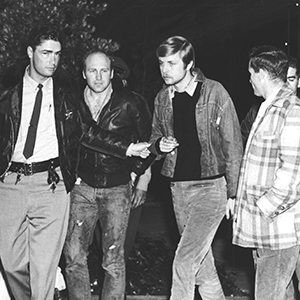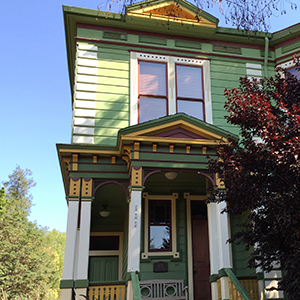Features & Columns
The Unforgettable Party
That No One Can Remember
the hazy history of the night that cemented the counterculture and changed America.
 BUSTED: Ken Kesey, Lee Quarnstrom, and Neal Cassady are arrested for marijuana possession in April of 1965.
BUSTED: Ken Kesey, Lee Quarnstrom, and Neal Cassady are arrested for marijuana possession in April of 1965.
Who knew? I mean who could have known, really? Maybe some of them did, maybe Kesey, because he seemed to have the big vision, and perhaps even a sense of cosmic history—he was "Captain Flag" after all, the literary "Swashbuckler" and "Chief"—but it took far more than one heartbeat and one big persona for the moon and the planets and the stars to align so perfectly, so opportunistically, in such a crystalline fashion as happened in the late autumn of 1965, precisely 50 years ago, but align they did.
The old buildings where many of the events took place are gone or moved—but the cultural legacies are still here. It's not really overstating things to say they changed the world, and Kesey and the various Merry Pranksters who organized these wild events were courageous in ways that we today cannot fully fathom, bold if not always fearless, breaking through, going places, crashing beyond the various doors of perception, to borrow an Aldous Huxley phrase, trying to plow through the mind-numbing blue-window conformity of the postwar American night.
San Jose was at the epicenter of this mid-20th Century revolution that transformed not just music and popular culture but politics, gender roles and work culture (casual Mondays anyone?) and formed the creative foundation for Silicon Valley's technology revolution.
San Jose City Hall's dome, of all places, stands today on South Fifth Street. It was there on that Saturday night in late 1965 that what has been identified as either the first (or second, depending on how you count) "Acid Test," staged with some of the major cultural figures of the era: Kesey, as in the novelist Ken Kesey, celebrated author of One Flew Over Over the Cuckoo's Nest and Sometimes a Great Notion; Neal Cassady of On the Road fame who was then living in Los Gatos with his wife and three kids; and Ken Babbs, Kesey's Prankster lieutenant, the "Intrepid Traveler," an ex-Marine and Vietnam War veteran who sat shotgun with Kesey all along the way.
Various members of that Palo Alto rock band who at their gig in Santa Cruz a week earlier were known as the Warlocks—Jerry Garcia, Phil Lesh, Bob Weir, Ron "Pigpen" McKernan and Bill Kreutzmann—but who would come to San Jose under their newly chosen appellation, the Grateful Dead, with various friends in attendance, including "Foxy" Connie Bonner and "Faithful" Sue Swanson.
And perhaps the most enduring Prankster of them all is Carolyn Adams, aka Mountain Girl—described by Tom Wolfe in The Electric Kool-Aid Acid Test as "a tall girl, big and beautiful, with dark brown hair flowing down to her shoulders"—mother of one of Kesey's kids (Sunshine) and later Garcia's wife. It was uncertain if she had been in Santa Cruz the week before—she couldn't remember, it's possible she was with family for Thanksgiving—but she told me this week that she was there in San Jose. She is absolutely certain.
And therein lies the rub. This history is all something of a blur. At an event celebrating the Golden Anniversary of these events this past week in Santa Cruz, artist and Prankster Roy Sebern said to me, "I don't remember anything, really. No details. It all just flowed together."
At one point when I pressed Lee Quarnstrom—former San Jose Mercury News columnist, lifelong Prankster and author of the thoroughly enjoyable memoir When I Was a Dynamiter—for precise data of those first events—to the point, I am sure, of being a pest—he wrote me back that "frankly I cannot remember who all was there, nor whether the whole Grateful Dead was there or just a few. Fifty years super-imposes either a golden hue or a thick fog over many memories É I doubt whether this is all that helpful to you, but my mental exercises in 1965 were often too strenuous to help me remember that party clearly."
"It's all a myth now anyway," Babbs, the Intrepid Traveler, said when I questioned some of the details of his recollection, laughing that deep wild Prankster laugh of his. "Tell it however you want."
 MAKE WAY: The house where the San Jose acid test took place was moved 11 blocks away to E. St. James Street.
MAKE WAY: The house where the San Jose acid test took place was moved 11 blocks away to E. St. James Street.
So be it. After conducting more than a dozen interviews and consulting more than two-dozen accounts of these events and what led up to them—in writing, in conversation—I suppose what emerges is more of an abstract painting than a precise photo-like rendition of history in the making. Let's be candid: My sources were all high on LSD and weed and who knows what else.
Plus, like Quarnstrom said, it's been 50 ragged years. The hue is indeed golden, if not a little tarnished. Myths have been created and legends destroyed. The historical narrative of the last half-century has been warped, carpet bombed and digitized. There's also been plenty of collateral damage along the way. Moreover, one of the mottos of Kesey & Co. was "never trust a Prankster," which adds yet another degree of difficulty to what is already a challenging task.
Let us start this tale in La Honda, in the Santa Cruz Mountains, a windy half-hour drive above Stanford, where Kesey had taken graduate courses in creative writing and where he began work on his brilliant —yes, it was brilliant—first novel, One Flew Over the Cuckoo's Nest, to be followed by his even better—yes, it was better—second novel, Sometimes a Great Notion.
It is tempting to say it all began there, but instead of envisioning it as a beginning, let us view it as an entrée into a cultural cataclysm, as a time & place where social magic and cultural alchemy took place.
Kesey liked to assemble people, one of the Pranksters told me, he liked to be the center of things, the center of attention if you will, and it was there in the musty cabins of La Honda that his wild army—dubbed by Babbs the Merry Pranksters—lived and loved, dropped acid and took cosmic journeys, had loads of fun (and some dark moments, too), and set out to change the world.
In the late spring of 1964, they embarked on what has become a legendary cross-country journey across the United States and back—ostensibly to attend the World's Fair in New York and to celebrate the book launch of Kesey's new novel, Sometimes a Great Notion—but perhaps more accurately to engage in a drug-fueled journey that they filmed (yes, filmed, in 16mm Kodachrome, no less) and recorded nearly every breath and step along the way. That journey has been chronicled ad nauseum—most notably in Tom Wolfe's seminal work of New Age journalism, The Electric Kool-Aid Acid Test (1968) and most recently in an engaging and entertaining documentary film by Alex Gibney and Alison Ellwood called Magic Trip: Ken Kesey's Search for a Kool Place (2011).
Once the bus ride was over, the Pranksters returned to La Honda and continued their quest, only to be raided in April 1965 by the San Mateo County Sheriff's Department, during which Kesey, Babbs, Mountain Girl and a host of other Pranksters were arrested and charged with various narcotics violations.
The heat was on. Journalist Lee Quarnstrom, who had hooked up with Kesey and his band in La Honda after writing an article for the San Mateo Times about the author, quit his gig, collected unemployment and moved into a cabin near Kesey's, was one of those caught up in the April 1965 raid.
As Quarnstrom describes the scene in his delightful memoir When I was A Dynamiter, La Honda was becoming something of a social pressure cooker. He says that the septic tank there had filled and sewage was backed up into the kitchen sink—and there were too many Hell's Angels hanging around, so that "one by one, the Pranksters living in La Honda began a Diaspora that brought me and a few others down the coast to Santa Cruz."
By November of 1965, Quarnstrom, along with other Pranksters and associates, including the entire Kesey family, Babbs, Demma, Mountain Girl, Bevirt and his girlfriend Space Daisy had moved into a run-down ranch house called The Spread a few miles east of Santa Cruz in the small, rural community of Soquel.
By then, Kesey and the Pranksters had brought their experiences with mind-expanding drugs to the masses. In the words of Wolfe, Kesey had intended to develop "a ritus, often involving music, dance, liturgy, sacrifice, to achieve an objectified and stereotyped expression of the original spontaneous religious experience." Kesey wanted to bend time. Kool-Aid spiked with LSD became the sacramental wine of the ritus, which in time, became known as an Acid Test.
According to Wolfe, the Pranksters had been looking for a larger, public venue in Santa Cruz to hold their embryonic event, but the "Pranksters were not the best mechanics at things, like hiring a hall." So the Spread in Soquel was a last-minute fallback location. Roughly 50 people showed up during the evening...


